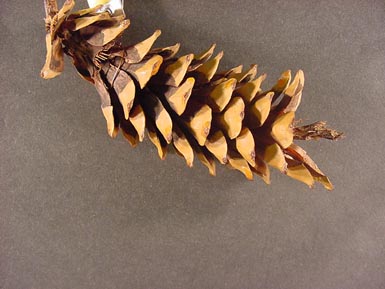Form: This is a large tree ranging from 150 to 180 ft. in height and a dbh of 2 to 4 ft. It has an open crown and is a self pruner.
Needles:
Arrangement: 5 per fascicle
Length: 2-4" long
Shape: slender; twisted
Other: blue-green with white lines on 2 of the 3 needle surfaces
Bark: The bark is thin and grayish-green in color when young. When mature it becomes up to 2 inches thick and grayish-purple in color with broken rectangular blocks. Dark bands often encircle the tree where whorls of branches have fallen off.
Cones: The cones scales are thicker and has a bronze apophysis when compared to eastern white pine. The cones are 5 to 12" long, thin, and curved.

Distinguishing characteristics: This tree has distinctive cones, thin grayish bark, an open crown with a bole free of branches for half it length and five needles per fascicle.
Range: This species ranges from the Pacific northwest to as far east as western Montana.
Silvics: This species is tolerant when young and later becomes intolerant when mature.The best growth occurs on rich, porous, moist soils.
Ecological and cultural importance: This tree is an extremely valuable timber species. It is used in numerous applications. It is browsed by deer and elk.